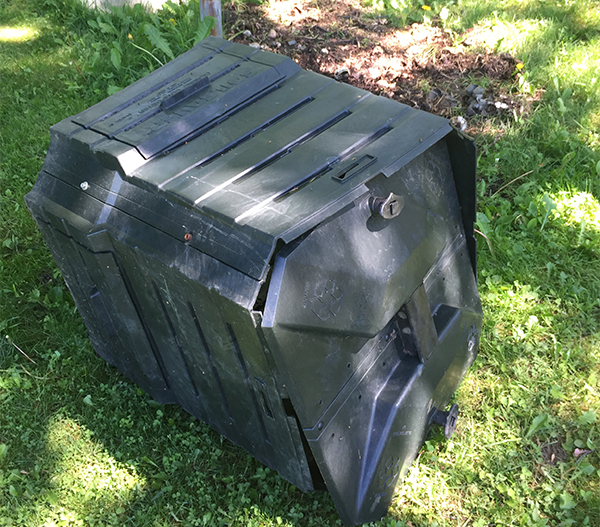Last week The Valley Reporter interviewed state wildlife officials and solid waste officials about the inherent conflict between state laws mandating that food and yard waste be banned from landfills in 2020 and the need for people to avoid creating nuisance bears.
When people compost at home, their home compost bins can become an attraction to hungry bears, both when they come out of hibernation and food is scarce but also throughout the summer if the bears get used to compost bins as a source of food. Nuisance bears lose their fear of humans and human interaction – which can be fatal for them and dangerous for humans as well.
Because transfer station operators will be able to charge people to bring food waste to dispose of at their facilities, that may increase the number of backyard composters. To that end local solid waste alliances such as the Mad River Resource Management Alliance (MRRMA) is offering a home composting workshop.
But, is that workshop and the tools being imparted in it the right approach to home composting? The Mad River Resource Management Alliance’s press release announcing the composting workshop begins with these words:
“So, if you have any banana peels and apple cores hanging around and you don’t want to throw them into the trash any more, we have a program coming up to help you out.”
Fruit peels, according to Forrest Hammond, bear project leader for the Vermont Department of Fish and Wildlife, are one of the most attractive scents for bears foraging for food.
The MRRMA press release about its workshop (June 17, Waitsfield town offices from 10 to 11 a.m.) also notes that black plastic Soil Saver compost bins will be for sale at half price. Those compost bins, by MRRMA manager John Malter’s admission, are definitively not bear proof.
Many composters eschew black plastic bins, or any enclosed bin, in favor of open bin composting or open pile composting. Many people have success by creating a three-sided pallet bin built into a hillside, with chicken wire encasing the pallets. Some find greater success using two chicken wire encased pallet boxes side by side, one with composting food waste, the other with yard and garden waste to continually add to the food side.
Some, like Warren resident and local composting guru Richard Czaplinski, use piles of compost on the ground with great success. He advocates for open spaces where people can envision two 5-foot-diameter circles side by side. These two spots are where a first and then second compost pile will be built after the first one has run its course of temperature rise and fall.
For Czaplinski, the secret to the compost degrading is using materials properly to get the temperature to rise sufficiently to biodegrade the materials. Here are the steps he suggests to create the right temps.
- The bottom layer of the pile should be rough, rather dry material such as big stalked weeds or thin woody brush. This layer should be about 3 or 4 inches thick and have a lot of air holes so air can enter the bottom of the pile to provide the necessary oxygen for the microorganisms in the pile.
- With this base, add a layer of dry (brown) material such as hay, straw or leaves about 3 inches thick. This is the carbon layer.
- Next add a layer of green material such as fresh cut grass clippings, freshly pulled or cut garden weeds and the vegetable compost from the kitchen. This green layer, the nitrogen layer, should be about 3 inches thick also.
- The last layer of this sequence is soil that provides a good population of microorganisms. Sprinkle a few shovels of soil over the entire pile so that soil is in contact with the material underneath, probably less than 1 inch thick.
- At this point, if the material added is dry, some water should be sprinkled over the pile. But not too much. The pile should be moist but not soggy.
- Now the pile will be about a foot high and the layering sequence outlined in Steps 2 through 5 are repeated – layer of brown stuff, layer of green stuff, layer of soil, water if needed. That’s all there is to it.
- Continue this layering sequence until the pile is at least 4 feet high. A compost pile needs to be big enough (at least a cube 3 feet on each side, preferably 4 feet on each side) to retain enough heat to provide a favorable environment for the microorganisms to multiply and break down the compost material. If properly built, a compost pile will heat up to as much as 150 degrees F in several days or more. By two weeks the temperature may have fallen back down to a 100 degrees F or less.
- At this point, the pile should be rebuilt using the layering sequence outlined above, except that the soil may be omitted and the old compost pile is used as the brown material. Fresh green stuff and garden/kitchen materials are used for the green layer. (Note: When rebuilding the pile, put outer layers of the old pile into the central portion of the new pile. This helps to degrade the material (plus weed seeds and pathogenic organisms if any) that was not subjected to the high temperatures and vigorous bacterial action).
- This pile is left to “cook” for two or three weeks at which time it can be used as compost in the garden. Some sorting or screening out of material that was not completely broken down may be necessary. However, this rougher material will continue to decay in the garden in areas where rougher material will not hinder the gardening being done. Or one may choose to rebuild the compost pile again. (Note: Use a coarse screen such as ¾- or 1-inch hardware cloth or just a six-tined fork to separate out any larger and unfinished material.)







